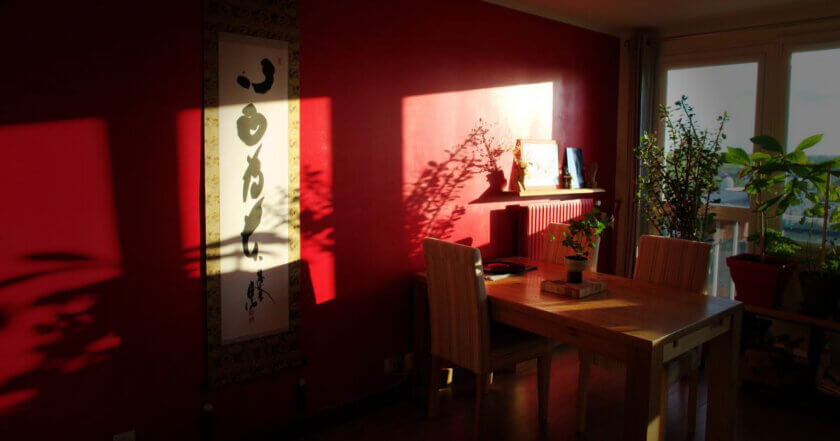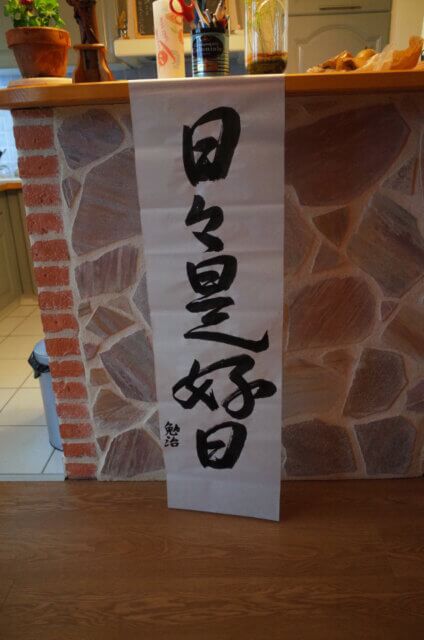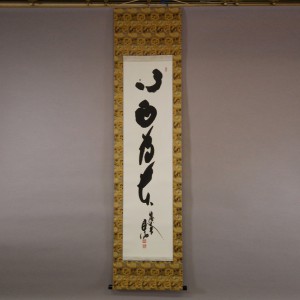Order from France for a Kakejiku Hanging Scroll with a Main Work by Takada Ryōshin, the Chief Priest of the Hōryū-ji Temple

Order from France for a Kakejiku Hanging Scroll with a Main Work by Takada Ryōshin, the Chief Priest of the Hōryū-ji Temple
We take orders for kakejiku both at home and abroad.
I’m genuinely grateful that we have been successfully dealing with our customers in over 40 countries and that gives us great pleasure.
Meanwhile, the number of repeat customers has been growing.
The topic I’m talking this time is a repeat order made by a French customer who previously purchased a kakejiku of Kobayashi Taigen, the chief priest of the Ōbai-in, a sub-temple of the Daitoku-ji of the Rinzai sect.
Here it is if you are curious about the earlier order.
Takada Ryōshin the Chief Priest of the Hōryū-ji Temple ‘Harmony Is the Greatest of Virtues’
The kakejiku shown below is the one ordered by the French customer.
The calligraphy expressing ‘Harmony is the greatest of virtues’ is a piece of work executed by Takada Ryōshin the chief priest of the Hōryū-ji temple.
The calligraphic main work conveys a mindset of the Japanese ‘The spirituality of being harmonious is essential for all aspects.’
The customer went through a thorough check on candidate kakejikus to purchase the one and eventually chose the kakejiku which, he said, matches with his mood enough to give him peace of mind.
Kakejiku Decorated in the Red Walled Room
After he received the kakejiku we swiftly dispatched, he sent us a photo of the piece, decorated in his distinctive room having a red wall, with the same presentation as the previous time.
The energy of a fervent red hue on the background and the one of the calligraphy are enhancing each other’s attraction.
The space which looks stunningly harmonious is expressing the saying precisely.
Our customer abroad sent us the photo of their piece displayed in their room from time to time and they’ve never failed to amaze me with their remarkable taste for the presentation.
Request for a Mounting Work
As we introduced the details in an article earlier, the customer is practicing calligraphy in France and on this occasion, sent us a photo of his piece of work too.

It’s from Zen philosophy’ Every day is a good day’.
‘Nichinichi kore kōjitsu’ is one of the Zen terminologies literally means ‘every single day is wonderful’.
The terminology has been interpreted extendedly to ‘endeavor to have good every single days’ and even further, ‘it’s wrong to judge good or bad of your day and be glad and sad by turns in the first place as you should cherish this moment .’ or ‘accept and appreciate as it is.’
I found the work impressive. The genuine style beyond my expectation is proving his devotion to the practice.
The delightful news is that he told me ‘One day when I’m satisfied with my work, I will request you to mount it.’
Lastly
It ends the episode of a repeated order from a customer in France.
Little by little, the number of our repeat customers abroad is rising and that makes me feel over the moon.
We’ll continuously devote ourselves to fully satisfy our customers globally.
Thank you for all your support.



